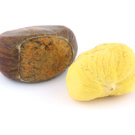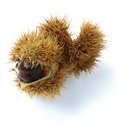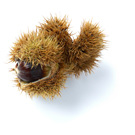The mighty Chestnut tree grows from 50 to 100 feet tall and can average up to 5 feet in diameter when fully mature. The mature heights of our nut trees for sale will vary from the smallest species of Chinquapins, often shrubby, to the giant tree of past American forests. Chestnut trees once dominated the forests of North America but were nearly wiped out by a devastating pathogenic fungus chestnut blight brought into the US in 1904. It took approximately 40 years to wipe out 40 billion Chestnut trees leaving behind few standing groves in Michigan, Wisconsin, California and the Pacific Northwest.
The mighty Chestnut tree grows from 50 to 100 feet tall and can average up to 5 feet in diameter when fully mature. The mature heights of our nut trees for sale will vary from the smallest species of Chinquapins, often shrubby, to the giant tree of past American forests. Chestnut trees once dominated the forests of North America but were nearly wiped out by a devastating pathogenic fungus chestnut blight brought into the US in 1904. It took approximately 40 years to wipe out 40 billion Chestnut trees leaving behind few standing groves in Michigan, Wisconsin, California and the Pacific Northwest.
The Chestnut Tree, a tree of antiquity has been found from Sardis in Asia Minor to all portions of Europe, the mountainous Mediterranean, Southwest and Eastern Asia and North America. The first known plantings of chestnuts were discovered around 2000 BC. The Chestnut genus Castanea, belongs to the family Fagaceae, which also includes ash and beech trees.
Willis Orchard Company has deciduous nut bearing chestnut trees for sale that require a partner tree for pollination in your orchard. The sweet nuts ripen in the fall of the year and are excellent for roasting or candied. As well as being consumed fresh, chestnuts can also be canned, pureed, or preserved in sugar or syrup. Nutritionally, chestnut fruits are considered a carbohydrate that contains very little fat, mostly unsaturated, and no gluten. Fresh chestnuts have less calories than walnuts, almonds, other nuts and dried fruit.
The Castanea does not grow well on alkaline soils and prefers a pH range 5.5-6. It grows best in a soil that has good drainage with adequate moisture and the tree prefers sloping, deep soils and soils derived from granite and sandstone; it also does not like shallow or heavy soils with impermeable clay subsoils. The Chinese chestnut prefers a fertile, well-drained soil, but it can grow well in fairly dry, rocky, or poor soils.



